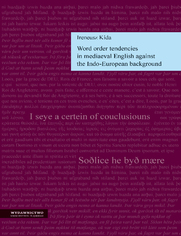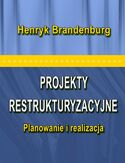Word order tendencies in mediaeval English against the Indo-European background - Onepress

ISBN: 978-83-801-2606-0
stron: 160, Format: ebook
Data wydania: 2015-09-03
Księgarnia: Onepress
Cena książki: 11,66 zł (poprzednio: 14,58 zł)
Oszczędzasz: 20% (-2,92 zł)
GĹ‚ównym celem pracy Ireneusza Kidy jest omówienie zmian w szyku zdaniowym Ĺ›redniowiecznej angielszczyzny na tle wybranych jÄ™zyków indoeuropejskich. KsiÄ…ĹĽka prezentuje jednoczeĹ›nie autorskÄ… metodÄ™ tworzenia korpusu tekstowego, sĹ‚uĹĽÄ…cego do badania zmian skĹ‚adniowych z OV na VO w Ĺ›rednio-angielszczyĹşnie, a takĹĽe miÄ™dzy innymi do badania tekstów staronordyckich i anglo-normaĹ„skich.
RozdziaĹ‚ pierwszy szczegóĹ‚owo omawia sposób, w jaki konstruowany byĹ‚ ów korpus. W rozdziale drugim dokonano z kolei analizy struktury szyku wyrazów w najdawniejszych inskrypcjach runicznych oraz w tekstach najstarszych jÄ™zyków germaĹ„skich pisanych prozÄ…, a równieĹĽ omówiono w nim pragermaĹ„ski szyk zdaniowy. RozdziaĹ‚y trzeci i czwarty prowadzÄ… nas natomiast do wniosku, ĹĽe definitywna zmiana na szyk VO w jÄ™zyku angielskim zaszĹ‚a w XII i XIII wieku oraz ĹĽe generalnie dokonywaĹ‚a siÄ™ ona szybciej w zdaniach gĹ‚ównych niĹĽ w zdaniach pobocznych.
W koĹ„czÄ…cym pracÄ™ rozdziale piÄ…tym autor dochodzi równieĹĽ do konkretnych wniosków dotyczÄ…cych trajektorii zmian szyku wyrazów w jÄ™zyku angielskim w szerszym kontekĹ›cie niektórych jÄ™zyków indoeuropejskich.
Osoby które kupowały "Word order tendencies in mediaeval English against the Indo-European background", wybierały także:
- English 4 IT. Praktyczny kurs j 49,67 zł, (14,90 zł -70%)
- Ucz si 9,67 zł, (2,90 zł -70%)
- Zyskaj angielski akcent. Kurs video. Trening wymowy 99,00 zł, (39,60 zł -60%)
- English 4 IT. Praktyczny kurs j 59,00 zł, (26,55 zł -55%)
- ASAP. Jak nauczyć się języka obcego tak szybko, jak to możliwe 34,15 zł, (15,71 zł -54%)
Spis treści
Word order tendencies in mediaeval English against the Indo-European background eBook -- spis treści
List of contents
Introduction / 7
The aim of the book / 7
The structure of the book / 8
C h a p t e r 1 Forming an annotated corpus
1.1. Outline of word order theories / 13
1.2. Forming our own corpus for the analysis of word order changes / 18
1.2.1. Introduction / 18
1.2.2. Tags used in the corpus / 19
1.2.3. The main clause / 20
1.2.4. The dependent clause / 23
1.2.5. Corpus flexibility: the investigation of parataxis and hypotaxis / 25
1.2.6. Concluding remarks / 36
C h a p t e r 2 Proto-Germanic word order
2.1. Proto-Indo-European and its later developments / 37
2.2. Proto-Germanic word order / 39
2.3. Word order in runic inscriptions / 40
2.4. How much does Old High German tell us about the Proto-Germanic word order? / 53
2.4.1. Introduction / 53
2.4.2. The analysis of Tatian (T1) / 54
2.4.3. The analysis of the Vulgate (L1) for comparison with Tatian (T1) / 56
2.4.4. The analysis of Tatian (T2) for comparison with T1 and L1 / 60
2.5. How much does Gothic tell us about the Proto-Germanic word order? / 61
2.5.1. Introduction / 61
2.5.2. Comparison of the Gothic Bible (Go1) with the Septuagint (Gr1) / 62
2.6. The West-Saxon Bible (WSB1): how much of Englishness? / 69
2.7. The influence of Latin and Greek upon the translations of the Bible into the oldest Germanic dialects / 71
2.8. Proto-Germanic word order according to our analysis / 73
C h a p t e r 3 Old English word order
3.1. Some characteristics of the Old English word order / 79
3.2. The analysis of the Old English Orosius / 83
3.3. The analysis of Ælfric’s Catholic Homilies / 85
3.4. Word order in the Anglo-Saxon Chronicle: comparison of the entries pre-1066 of the A-manuscript and the E-manuscript / 88
3.5. The Parker Chronicle: the pre-891 and the 891—1066 periods compared / 93
3.6. The Peterborough Chronicle: the pre-891 and the 891—1066 periods compared / 97
3.7. Old Norse: how much of Scandinavian influence upon the word order of English? / 102
3.7.1. The socio-linguistic background / 102
3.7.2. The analysis of word order in Heimskringla / 104
C h a p t e r 4 Middle English word order
4.1. Towards the shaping of the Middle English word order / 109
4.2. Word order in the entries 1067—1121 of the Peterborough Chronicle / 110
4.3. Word order in the First Continuation of the Peterborough Chronicle (entries 1122—1131) / 111
4.4. Word order in the Second Continuation of the Peterborough Chronicle (entries 1132—1154) / 114
4.5. The analysis of Juliana / 118
4.6. Introduction to the analysis of Ancrene Wisse / 120
4.6.1. Word order in Ancrene Wisse / 121
4.7. The analysis of the Prose Treatises of Richard Rolle de Hampole / 124
4.8. The analysis of Geoffrey Chaucer’s Astrolabe / 126
4.9. The analysis of the Wycliffe’s Bible (WB1) / 128
4.10. Anglo-Norman: how much of influence upon the English word order? / 130
4.10.1. The socio-linguistic background / 130
4.10.2. Some facts concerning the word order of Anglo-Norman based on the comparison of Foedera and its Latin counterpart / 134
4.10.3. The analysis of word order in Foedera / 136
C h a pt e r 5 The trajectory of word order change in English
5.1. Conclusions / 139
5.2. The locus of VO spread: main vs subordinate clauses / 139
5.3. The diachrony of the development of word order in English: from pre-Proto-Germanic to Late Middle English / 141
Bibliography / 147
References / 147
Sources / 150
Assisting websites / 151
Streszczenie / 153
Résumé / 154





